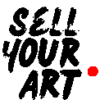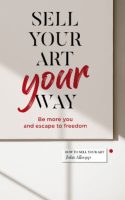(This is video 2. See also video 1: what to send, and video 3: what to offer.)
Hi
Today I want to show you the idea of a nurture sequence that can help you live the artist life you want.
It can pay for your marketing (and more), build your art sales and grow you a fanbase of people that feels really right and supportive of what you’re doing. And it’s all automatic once you’ve set it up.
Imagine that. Complete artistic independence.
Where will you be in a year’s time, or ten year’s time, if you get this sorted today? Bigger studio? Higher prices? More respect?
Someone in the questionnaire responses said “sorry, nodded off”*. In other words, you didn’t choose to be an artist so you could write emails. That’s kinda the point of this. If you can manage to do this once, it’s automated for ever more. But I do totally get it, and if you’d prefer to throw money at it, you’re welcome to get in touch and I’ll write your sequence and set it up for you.
Basically if you think automated emails are the last thing you want to be writing and setting up, you’re in the right place because
a) I don’t really care, you still need to do it, and
b) I’ll walk you through it or if needed, I’ll
c) set it up for you (after 40 years in marketing and PR, for me it’s easy (not cheap, good)).
But you can do this and I’m going to show you how.
In the end, having a mailing list that magically stays updated and is chock full of people who have a genuine interest in what you’re doing and who are prepared to invest some time and headspace into your art .. it’s a beautiful thing. It’s regular income. It’s emotional support. It’s independence.
In the last video, I showed you 5 ways to woo your list, that was about what to send to those on your list. But most artists have got 50 or 80 random people on a list somewhere, they haven’t mailed for a couple of years, they would have to dig out their Mailchimp login and so on. And when those people joined your list, not a lot happened. So we’re going to start filling your list with your ideal buyer in the next video, but before we do that, we need to think about what they get when they sign up.
People sign up to a mailing list for a reason (see video 3, your offer). Step one is that when someone signs up to your mailing list, you’ll fulfil that reason. “Here’s the thing I promised you.”
But .. it’s a little like that awkward first moment perhaps at a party when you meet someone you are attracted to and you think maybe they like you too and after the first hello there’s a pause before the conversation starts.
Here you are. Here they are.
Now you can walk away.
Or you can explore and start building a relationship.
In person, you can ask questions. But in an email nurture sequence we want to demonstrate that we understand their wants (because we’re in the business of solving problems) and we have something they can value.
Show them something they didn’t know. Inspire them.
So a nurture sequence is a series of emails that are sent automatically to anyone who signs up to your mailing list. (It’s OK, if they don’t like them, they can unsubscribe and you want them to.)
Remember Carnegie’s book How To Win Friends and Influence People? The big take-home was .. talk to people about them. Ask questions. Get them to talk about themselves. They’ll think you’re fascinating and will love you for it.
This is never going to feel like you’re “bothering people”. It’s not “pushy” or “too salesy”. You’re giving them what they want, and everyone’s into what they want.
The reason I mention that is we always want to be focussed on them. So if you sent out a series of emails all about yourself, it wouldn’t hit home. I remember going to a few presentations locally .. a graphic designer and a musician particularly .. where they essentially talked about themselves throughout and bored the pants off all and sundry. The audience’s conclusion .. well he was a bit of a prick to be honest, just .. full of himself.
So that’s no way to build a relationship.
What can you say that’s unique to you and your art practice but is buyer-focussed?
Here are seven prompts to get you started but this is very much for you to think about and design for yourself because we do want to highlight your uniqueness.
Each of these could prompt you to write an email and set it within the nurture sequence.
- What do people think (about you) that isn’t right? What are some misconceptions about you, or your type of art, or art or artists in general?
- When, exactly, was the instant that you changed and got on the path you are on now? Not, “oh, I’ve always been a drawer”. The moment, and how it changed you.
- Stories, particularly about happy buyers. People who had a problem that you fixed.
- Guidance / education, things like .. how to choose a painting for a room (not, by the way, how to paint, these are about overcoming an obstacle a buyer has)
- Positioning .. why should anyone listen to you? What’s your background, education, training, experience?
- What’s different about you?
- What stops people buying art / buying your art, and how can you answer that ‘objection’?
If you mix in a call to action or two, for instance, “If you’d like to discuss a commission, get in touch” then your mailing list process which includes
- automatically connecting you to the right sort of buyer,
- tempting them to join your mailing list (that’s the next video) and
- sending them the nurture sequence we’re talking about here,
could happily and regularly bring in an income .. even if everyone you brought in to your list unsubscribed a month or two later.
But of course most stay. So you end up with a bigger and bigger fanbase that you can call on for support, whether you want people to turn up to your preview or to buy a work directly online or buy a pack of your Christmas cards or whatever.
Just be clear that your nurture sequence is about building trust, educating them on how you fix their problems, and inspiring them. The sales come later, based on your trust relationship.
If you groaned a little at the task of building a nurture sequence, you might like this ..
You don’t have to build it all at once. If all you do is create a good welcome email, that’s a great start. When you’re ready, add a follow up email.
OK, that’s not perfect because ideally you’ll want to drop in some open loops. Did you spot my one earlier? I said that my next video will be about getting people to join your list. If you heard that, you’re now primed that there’s a problem (you need to get people to join this mailing list of yours) and I’ll solve that problem for you in my next video. So if that resonates with you your mind will look out for the next video. That’s an open loop. An unfulfilled promise.
Ideally, the emails in your nurture sequence will hook together like that. You can either think it all through and build it in pieces over time, or just write the different standalone emails and then once you see them all, work out how to incorporate some open loops and go back in for an hour’s editing and tidyup.
But the point is .. a little bit of nurture sequence is an improvement so make a start and you can just keep building it. Write or edit your immediate email response, and then create another one that automatically gets sent in a day, maybe another one the day after, then another a couple of days later, then maybe another in three days and keep going with slowly growing spaces if you have enough to say. Your nurture sequence could ultimately last a month, for example.
The goal is that once we’ve attracted someone’s attention and they like what you do, we get them on your list, show them how you can help and they become a stronger fan of yours. When you have something to sell, your list will be the first place you turn to, which gives you an easy way to sell your work (just send an email, no commission, instant), and gives them the feeling of being special, insiders, onside, part of the team.
Alright, so I do have one more video for you where we’ll talk about how to find your ideal buyer and get them to sign up for your list, so they see this fabulous nurture sequence of yours.
Stay safe, sell art.
J
* I had people say nice things as well 🙂 Having a list “makes me feel good” and it “resonates”.

